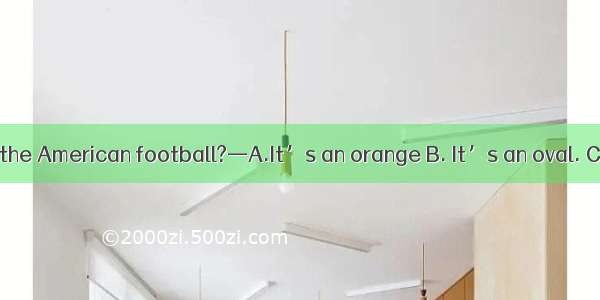
From Wikipedia, the free encyclopedia
A diagram showing an "I Formation" on offense and a 4-3 Formation on defense
InAmerican football, each team has eleven players on the field at one time. The specific role that a player takes on the field is called their position. Under the modern rules of American football, teams are allowed unlimited subsititutions, that is teams may change any number of players after any play. This has resulted in the development of three "platoons" of players, the offense (the team with the ball, who is trying to score), the defense (the team trying to prevent the other team from scoring, and to take the ball from them), and the special teams (who play in kicking situations). Within those platoons, various specific positions exist depending on what the player"s main job is.
Offensive line
The offensive line (on left, in orange shirts) consists of a center (with ball in hand) two guards on either side of him, and two tackles.
The offensive line is primarily responsible for blocking. During normal play, offensive linemen do not handle the ball, unless the ball isfumbled by a ball carrier, or when a player who is normally an offensive lineman takes a different position on the field. The offensive line consists of:
Center (C)
The center is the player who begins theplay from scrimmage bysnapping the ball to a back. As the name implies, the center usually plays in the middle of the offensive line, though some teams may employ an unbalanced line where the center is offset to one side or another. Like all offensive lineman, the center has the responsibility to block defensive players. The center often also has the responsibility to call out blocking assignments and make last second adjustments depending on the defensive alignment.
Offensive guard (G)
Two guards line up directly on either side of the center. Like all interior linemen, their function is to block on both running and passing plays. On some plays, rather than blocking straight ahead, a guard will "pull", whereby the guard comes out of his position in line to lead block for a ball carrier, on plays known as "traps" (for inside runs), or "sweeps" (for outside runs), or "screens" (for passing plays)
Offensive tackle (T)
Two tackles play outside of the guards. Their role is primarily to block on both running and passing plays. The area from one tackle to the other is an area of "close line play" in which blocks from behind, which are prohibited elsewhere on the field, are allowed. For a right-handed quarterback, the left tackle is charged with protecting the quarterback from being hit from behind (known as his "blind side"), and this is usually the most skilled player on the offensive line. Like a guard, the tackle may have to "pull," on a running play, when there is a tight end on his side.
Backs and receivers
#14 Anthony Morelli hands the ball off to his #33 in their season opener.
The six backs and receivers are those that line up outside or behind the offensive line. There are four main positions in this set of players:
Quarterback (QB)
The quarterback is the player who receives the ball from the center to start the play. The most important position on the offensive side, the quarterback is usually responsible for receiving the play from the coaches on the sideline and communicating the play to the other offensive players in thehuddle. The quarterback may need to make changes to the play at the line of scrimmage (known as an "audible"), depending on the defensive alignment. At the start of the play, the quarterback may be lined up in one of two positions. If they are positioned directly in contact with the center, and receive the ball via direct hand-to-hand pass, they are said to be "under center". If they are lined up some distance behind the center, they are said to be "in the shotgun". Upon receiving the snap, the quarterback has three basic options to advance the ball. They may run the ball themselves, they may hand it to another eligible ball carrier to run with it, or they may execute aforward pass to a player downfield.
Running back (RB)
Running backs are players who line up behind the offensive line, who are in position to receive the ball from the quarterback and execute arushing play. Anywhere from one to three running backs may be utilized on a play (or even none, a situation typically known as an "empty backfield"). Depending on where they line up, and what role they have, running backs come in several varieties. The "tailback" (or sometimes the "halfback", though this term is somewhat archaic) is often a team"s primary ball carrier on rushing plays. They may also catch passes, often acting as a "checkdown" or "safety valve" when all other receivers on a pass play are covered. The "fullback" is often larger and stronger than the tailback, and acts primarily as a blocker, though the fullback may also be used for catching passes or for rushing as a tailback does. Fullbacks often line up closer to the line of scrimmage than tailbacks do, so they may block for them. A "wingback" or a "slotback" is a term for a running back who lines up behind the line of scrimmage outside the tackle or tight end on the side where positioned. Slotbacks are usually only found in certain offensive alignments, such as theflexbone formation. A similar position, known as theH-back, is actually considered a modification of the normal tight end position (see below).
Wide receiver (WR)
A wide receiver (#87, in white) begins a play in the flanker position
The wide receivers are pass-catching specialists. Their main job is to run pass routes and get open for a pass, although they are occasionally called on to block. Wide receivers generally line up split "wide" near the sidelines at the start of the play. Wide receivers, like running backs, come in different varieties depending on exactly where they line up. A wide receiver which is directly on the line of scrimmage is called a "split end", and is counted among the seven required players on the line of scrimmage. A wide receiver which lines up behind the line (and thus counts as one of the four backs) is called the "flanker". A wide receiver which lines up between the outermost wide receiver and the offensive line is said to be "in the slot" and is called the "slot receiver".
Tight end (TE)
Tight ends play on either side of, and directly next to, the tackles. Tight ends are considered a hybrid player, something between a wide receiver and an offensive lineman. Because they play next to the other offensive lineman, they are frequently called on to block, especially on running plays. However, because they are eligible receivers, they may also catch passes. The position known as theH-back is a tight end who lines up behind the line of scrimmage, and is thus counted as one of the four "backs", but otherwise his role is similar to that of other tight ends.
Depending on the style of offense the coaches have designed, the game situation, and the relative skill sets of the players, teams may run formations which contain any number of running backs, wide receivers, and tight ends, so long as the mandated "four backs and seven on the line" rule is followed. For many years, the standard set consisted of the quarterback, two running backs (a tailback/halfback and a fullback), two wide receivers (a flanker and a split end) and a tight end. Modern teams show a wide variety of formations, from a "full house" formation with three running backs, two tight ends, and no wide receivers, to "spread" formations featuring four or five wide receivers, sometimes without any running backs.
Defense
Defensive line
The four defensive linemen (in red) have their hands on the ground in a "three point stance".
Like their offensive counterparts,defensive linemen line up directly on the line of scrimmage, close to the ball. There are two positions usually considered part of the defensive line:
Defensive tackle (DT);
Sometimes called a defensive guard, defensive tackles play at the center of the defensive line. Their function is to rush the passer (if they can get past the offensive linemen blocking them), and stop running plays directed at the middle of the line of scrimmage. A defensive tackle who lines up directly across from the ball (and therefore is almost nose-to-nose with the offense"s center) is often called a nose tackle or nose guard. The nose tackle is most common in the 3-4 defense. Most defensive sets have from one to two defensive tackles. Sometimes, but not often, a team will employ three defensive tackles.
Defensive end (DE)
The two defensive ends play next to the defensive tackles, at the edges of the defensive line. Their function is to attack the passer or stop offensive runs to the outer edges of the line of scrimmage (most often referred to as "containment"). The faster of the two is usually placed on the right side of the defensive line (quarterback"s left) because that is a right-handedquarterback"s blind side.
Often, though not always, a defensive lineman will have his "hand(s) on the ground," in a three- or four-point stance before the ball is snapped; this distinguishes his pre-snap stance from a linebacker, who begins in a two-point stance (i.e. without a hand touching the ground).
Linebackers
This defense (in white) is in a base . Just behind the four defensive linemen (whose hands are on the ground) are three linebackers (numbers 55, 3 &16), and further back are two safeties (numbers 24 & 44). Out-of-frame are the two cornerbacks.
Linebackers play behind the defensive line and perform various duties depending on the situation, including rushing the passer, covering receivers, and defending against the run.
Middle linebacker (MLB)
Sometimes called the "inside linebacker" (especially in a3-4 defense), and known colloquially as the "Mike" linebacker, the middle linebacker is often known as the "quarterback of the defense", as they are frequently the primary defensive play callers and must react to a wide variety of situations. Middle linebackers must be capable of stopping running backs who make it past the defensive line, covering pass plays over the middle, and rushing the quarterback onblitz plays.
Outside linebacker (OLB)
Outside linebackers are given different names depending on their role and the philosophy of the team. Some teams keep their outside linebackers on the same side of the field at all times, and thus they are known as "right outside" (ROLB) and "left outside" (LOLB). Some teams define them by their role; as playing either "strongside (SLB) or "weakside" (WLB). The strongside, or "Sam", linebacker lines up on the same side as the offensivetight end and often is responsible for covering the tight end or running back on pass plays. The weakside, or "Will", linebacker lines up on the side of the offensive line without a tight end, and is often used to rush, orblitz the quarterback, or may need to cover a running back on pass plays.
Defensive backs
Cornerback gets a read on the offense just prior to the start of play
Defensive backs, also known as the "secondary", play either behind the linebackers or set to the outside, near the sidelines. Defensive backs are primarily used to defend against pass plays, by covering wide receivers and tight ends to prevent them from catching the ball, or to attempt tointercept the pass from the quarterback. Defensive backs also act as the last line of defense on running plays, and need to be able to make open field tackles, especially when the ball carrier has gotten past the other defenders. A normal complement of defensive backs includes two cornerbacks and two safeties, though specialty defensive backs (nickelbacks and dimebacks) can be brought in in place of linebackers and defensive lineman, when there is need to cover additional pass receivers.
Cornerback (CB)
Typically two players who primarily cover the wide receivers. Cornerbacks attempt to prevent successful quarterback passes by either swatting the airborne ball away from the receiver or bycatching the pass themselves. In rushing situations, their job is to contain the runner, either by directing him back to the middle of the field to be tackled, by tackling him themselves, or by forcing him out of bounds.
Safety (S)
The safeties are the last line of defense (farthest from the line of scrimmage) and usually help the corners with deep-pass coverage. The strong safety (SS) is usually the larger and stronger of the two, providing extra protection against run plays by standing closer to the line of scrimmage, usually on the strong (tight end) side of the field. The free safety (FS) is usually the smaller and faster of the two, and is usually the deepest player on the defense, providing help on long pass plays.
Nickelback andDimeback
In certain formations, the defense may remove a linebacker or a defensive lineman to bring in extra pass coverage in the form of extra defensive backs. A formation with five defensive backs is often called a "nickel" formation, and the fifth (extra) defensive back is called a "nickelback" after the U.S.nickel coin, a five-cent piece. By extension, a formation with a sixth defensive back is called a "dime package", a 10-cent dime coin being "two nickels (nickelbacks)." Rarely, a team may employ seven or eight defensive backs on certain plays.
Defensive formations are often known by a numerical code indicating the number of players at each position. The two most common formations are the3–4 defense and the4–3 defense, where the first number refers to the number of defensive linemen, and the second number refers to the number of linebackers (the number of defensive backs can be inferred, since there should be eleven players on the field.) Thus, 3–4 defense will consist of three defensive linemen (usually a nose tackle and two defensive ends), four linebackers, and four defensive backs (two cornerbacks, a strong safety, and a free safety).
Special teams
A placekicker (, #2) prepares to kick the ball from the hand of a holder (, #9).
"Special teams" redirects here. For the ice hockey definition of "special teams," seepowerplay andshort handed.
Special teams are units that are on the field during kicking plays. While many players who appear on offensive or defensive squads also play similar roles on special teams (offensive linemen to block, or defensive players to tackle) there are some specialist roles which are unique to the kicking game.
Kicker (K)
Also called the "placekicker", he handleskickoffs andfield goal attempts. Both situations require the kicker to kick the ball off of the ground, either from the hands of a "holder" or off of a "tee". Some teams will employ two kickers, one for each role. Most however use a single kicker for both jobs, and rarely, the same player may alsopunt.
Holder (H)
Usually positioned 7-8 yards from theline of scrimmage, he holds the ball for the placekicker to kick. The holder is often a backup quarterback or a punter.
Long snapper (LS)
A specialized center whosnaps the ball directly to the holder or punter. This player is usually distinct from the regular center, as the ball often has to be snapped much farther back on kicking plays.
Punter (P)
Punting requires the player to drop the ball from their hand and kick it from the air. It is done to relinquish possession to the defensive team. Punting is usually only done on fourth down.
Punt returner (PR) andKick returner (KR)
Returners are responsible for catching kicked balls (either on kickoffs or punts) and running the ball back. These are usually the fastest players on a team. Teams may use the same player for both positions, or may have a separate returner for punts and for kickoffs.
Upback
A blocking back who lines up approximately 1-3 yards behind the line of scrimmage in punting situations. Because the punter plays so far back, the upback frequently makes the line calls and calls for the snap to be received by the punter. Their primary role is to act as the last line of defense for the punter. Upbacks may occasionally receive the snap instead of the punter on fake punts.
Gunner
A player on kickoffs and punts who specializes in running down the field very quickly in an attempt to tackle the kick returner or the punt returner. They usually line up near the sidelines where there will be fewer blockers and thus allow them to get down the field quickly.
Special teams positions
Positions inAmerican football andCanadian football
OffenseDefenseSpecial teams
LinemenGuard,Tackle,CenterLinemenTackle,End,Nose tackleKicking playersPlacekicker,Punter,Kickoff specialist
QuarterbackLinebackersSnappingLong snapper,Holder
BacksHalfback (Tailback),Fullback,H-backBacksCornerback,SafetyReturningPunt returner,Kick returner
ReceiversWide receiver,Tight end,SlotbackNickelback,DimebackTacklingGunner
Formations –Nomenclature
















